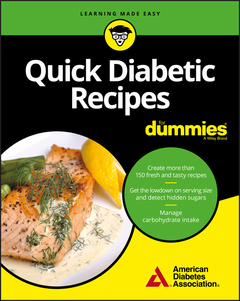Quick Diabetic Recipes For Dummies
Auteur : American Diabetes Association

100+ quick and delicious diabetes-friendly recipes
If you have diabetes, watching what you eat is one of the most important things you can do to stay healthy. With the help of the American Diabetes Association, Quick & Easy Diabetic Recipes For Dummies offers 100+ healthy, diabetes-friendly recipes and meal planning ideas?without sacrificing taste. Plus, Quick & Easy Diabetic Recipes For Dummies provides expert tips on the types of food you should keep stocked in your kitchen, advice on healthy cooking techniques, ways to lower fat and cholesterol, and most importantly, what to eat with diabetes.
According to the World Health Organization, the number of adults worldwide affected by diabetes has quadrupled since 1980 to 422 million. Nearly one in 11 people in the United States now have diabetes or prediabetes, and unhealthy eating can worsen the condition and hinder efforts at better management. While those numbers are alarming, the good news is that you can cook and eat your way to better health?and this book makes it easy!
? Make more than 100 tasty recipes, many of which cook in 30 minutes or less
? Get the total grams of carbohydrates and other nutrients per serving
? Discover ways to keep a healthier kitchen
It?s never been simpler?or tastier?to keep up with your diabetes management.
Introduction 1
About This Book 1
Foolish Assumptions 2
Icons Used in This Book 3
Beyond the Book 3
Where to Go from Here 4
Part 1: Getting Started with Diabetic Cooking 5
Chapter 1: What Can I Eat? 7
Introducing the Importance of Carbohydrates 8
Eat Your Vegetables! 8
Nonstarchy vegetables 9
Starchy vegetables 9
An Apple a Day 10
Making Your Grains Count 11
Choosing Lean Protein 12
Poultry 12
Fish and seafood 13
Plant-based proteins 13
Red meats 14
Fat: Good or Bad? 15
Unhealthy fats 15
Healthy fats 17
The Do’s and Don’ts of Dairy 18
What Can I Drink? 18
Steering clear of sugary beverages 19
Choosing the best drinks 19
Is alcohol off limits? 19
Chapter 2: Stocking Your Pantry 21
Getting Started: Taking Inventory 21
Kitchen tools and cookware 22
Cleaning out your kitchen 22
Stocking Up on the Essentials 23
Pantry staples 23
Fresh staples 27
Making the Most of Your Pantry 28
Chapter 3: Making It Healthy: Tips and Techniques 29
It’s All about Ingredients 30
Shop wisely 31
Ingredient swaps for healthier recipes 32
Adjusting Your Cooking Habits 34
Focusing on technique 34
Reducing the amount of fat you add to dishes 36
Amping up the flavor 36
Eating Less 37
A New Attitude 38
Part 2: Digging into Main Dishes 41
Chapter 4: Breakfasts 43
Chapter 5: Soups and Stews 53
Chapter 6: Pasta 69
Chapter 7: Poultry 81
Chapter 8: Beef, Pork, Lamb, and Veal 103
Chapter 9: Seafood 119
Part 3: Whipping Up Sides and Supporting Dishes 137
Chapter 10: Appetizers 139
Chapter 11: Salads and Dressings 155
Chapter 12: Vegetables 181
Chapter 13: Rice and Potatoes 197
Chapter 14: Breads and Muffins 207
Chapter 15: Desserts 217
Part 4: Planning Your Meals 243
Chapter 16: A Little Planning Goes a Long Way 245
Introducing the Idea of Meal Planning 245
Defining Macronutrients 246
Carbohydrate: Converts into glucose 247
Protein: Builds strong bodies 247
Fat: Healthy types are helpful 247
First Things First: Meeting with a Dietitian 248
More Than One Way to Plan a Meal 249
Chapter 17: The Plate Method 251
Using the Plate Method 251
Divide and fill 252
Healthy options for your plate 254
More Portion Control Advice 256
Simple portion size estimation guidelines 256
Portion control tips 257
Chapter 18: Carbohydrate Counting 259
Know Your Carbs 260
How Much Carbohydrate Is Right For Me? 261
Basic Carbohydrate Counting: Be Consistent 262
Advanced Carbohydrate Counting 263
Calculating specific carbohydrate amounts 263
Using nutrition panels 264
Getting (even more) technical 267
Chapter 19: Meal Planning with Food Choices/Exchanges 269
What Are Food Choices? 270
Getting to Know the Food Lists 270
Starch 270
Fruits 271
Milk and Milk Substitutes 272
Nonstarchy Vegetables 272
Sweets, Desserts, and Other Carbohydrates 273
Protein 274
Fats 274
Free Foods 275
Combination Foods 275
Fast Foods 276
Making Food Choices/Exchanges Work for You 276
Chapter 20: Other Meal Planning Methods 279
Eating Patterns and Meal Planning 280
Eating Mediterranean style 280
The DASH eating plan 281
Going vegetarian/vegan 282
A low-carbohydrate eating pattern 283
The skinny on low-fat diets 284
Glycemic Index and Load 284
Part 5: The Part of Tens 287
Chapter 21: Ten Tips for Smart Snacking 289
Talk to Your Dietitian 290
Choose Your Snacks Wisely 290
Watch Your Portions 291
Avoid Mindless Eating 292
Stock Up on Healthy Options 292
Be Selfish with Your Snacks 293
Snacks for Low Blood Glucose 293
Snack before a Big Meal or Event 294
Think Outside the Box 295
Don’t Deprive Yourself 295
Chapter 22: Ten Strategies for Healthier Restaurant Meals 297
Research Your Restaurant 298
Ask Your Server 298
Make Special Requests 299
Helpful Substitutions 299
Skip the Extras 300
Don’t Drink Your Calories 301
Take Half Home 301
Get Creative with the Menu 301
Order Takeout before You’re Hungry 302
Choose Fast Foods Wisely 302
Appendix: Food Lists 305
Index 335
The American Diabetes Association leads the fight against the deadly consequences of diabetes by funding research, delivering services to communities affected by diabetes, and providing objective and credible information. It is led by a network of more than one million volunteers and nearly 14,000 healthcare professionals.
Date de parution : 01-2018
Ouvrage de 360 p.
18.5x23.4 cm
Thèmes de Quick Diabetic Recipes For Dummies :
Mots-clés :
American Diabetes Association



